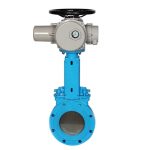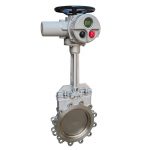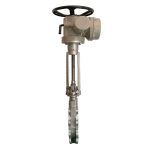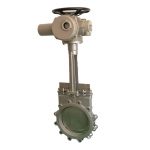DN100 (4in) Electric Knife Gate Valve with WCB Wafer Flange for Water, Gas, Dust and Particle Media Control
I. Product Overview
II. Key Attributes and Specification Parameters
Basic Attributes
- Structure Design: Knife gate valve with a linear-acting gate (knife-shaped edge) and wafer flange connection. The gate moves vertically via electric actuation to open/close the flow path; its sharp edge shears through media containing fibers, dust, or small particles to prevent clogging.
- Body Material: WCB cast carbon steel (ASTM A216), selected for high mechanical strength (tensile strength ≥485MPa) and cost-effectiveness. WCB resists mild corrosion from water and gas, and withstands temperatures up to 150℃ without deformation—ideal for non-corrosive, medium-pressure industrial scenarios.
- Internal Component Materials:
- Gate Valve core: 1.4529 (super austenitic stainless steel) or Wear-resistant alloy steel, featuring a precision-ground knife edge for shear capability and resistance to abrasion from particles.
- Stem: SS304 stainless steel, preventing rust and ensuring smooth vertical movement; paired with a graphite packing gland to eliminate stem leakage.
- Seal Material: PTFE (polytetrafluoroethylene) soft seal for low-temperature, clean media (water, gas), or metal hard seal (SS304) for high-temperature, abrasive media (dust, particles)—both achieving tight shutoff to minimize media loss.
- Pressure Rating: PN16 (1.6MPa), suitable for medium-pressure pipelines in municipal water supply, gas distribution, and industrial process systems.
- Temperature Range: -20℃ to +150℃ (PTFE seal) / -20℃ to +200℃ (metal seal), accommodating normal-temperature water, heated gas, and low-temperature dust-laden air.
- Nominal Diameter Range: 2in to 24in (DN50 to DN600), with a focus on DN100 (4in) for balanced flow rates—suitable for both small-batch process lines (e.g., chemical dosing) and large-scale transfer pipelines (e.g., mining slurry).
- Connection Type: Wafer flange (ANSI/ASME B16.5 Class 150, DIN EN 1092-1 PN16), a compact design that clamps between two pipeline flanges without requiring its own bolt holes. This reduces valve weight by 30% compared to full-flange models and saves installation space.
- Actuation System: Electric actuator with linear drive, offering:
- Voltage Compatibility: AC 220V, AC 110V, DC 24V (±10% fluctuation tolerance), Adapt to global power systems.
- Control Modes: On-off control (for basic shutoff) and proportional control (via DC 4-20mA signal or Modbus RTU communication), enabling precise flow adjustment with ±0.8% control precision.
- Protection Ratings: IP65 (dust-tight, water-resistant) as standard; optional IP67 for damp environments (e.g., wastewater plants) or explosion-proof (EXD IIB T4) for hazardous gas zones.
- Emergency Function: Manual override handle (mechanical) for operation during power failure, ensuring system continuity.
- Media Compatibility: Clean water, raw water, natural gas, biogas, dry dust (e.g., cement powder, coal dust), and fluids containing small solid particles (e.g., mining slurry, sewage sludge)—excluding highly corrosive media (e.g., strong acids).
- Design and Testing Standards:
- Design: ASME B16.34 (valves for flanged/threaded/welding ends), API 600 (steel gate valves), GB/T 12234 (flanged knife gate valves).
- Testing: API 598 (shell and seat leakage testing), IEC 60529 (IP rating testing), ensuring structural integrity and sealing performance.
- Warranty: 1 year (covers valve body and actuator defects under normal operation).
Product Overview
III. Product Features
- Knife Edge Shear Capability: The gate’s sharp, precision-ground edge creates a shearing effect when closing, cutting through fibers (e.g., sewage hair), dust agglomerates (e.g., cement clumps), or small particles (e.g., sand)—a critical advantage over standard gate valves, which often clog with such media. This eliminates the need for frequent disassembly and cleaning, reducing maintenance downtime by 40-60%.
- Wafer Flange Compactness: The wafer design clamps directly between pipeline flanges, requiring no dedicated bolt holes in the valve body. This reduces overall valve weight (DN100 model weighs ~35kg, vs. 50kg for full-flange gate valves) and saves installation space—ideal for tight pipelines in factories or municipal pump stations.
- Dual Seal Versatility: PTFE soft seals deliver API 598 Class VI bubble-tight shutoff for clean media (e.g., drinking water), preventing leakage and water waste. Metal hard seals (SS304) withstand abrasion from particles (e.g., mining slag) and high temperatures (up to 200℃), maintaining sealing integrity for 5,000+ cycles.
- Precise Electric Control: The actuator’s DC 4-20mA signal compatibility enables proportional flow regulation—critical for applications like sludge dosing in wastewater treatment or dust flow control in cement plants. Modbus RTU communication allows integration into SCADA systems, enabling remote monitoring and adjustment (e.g., from a central control room).
- Wide Voltage Compatibility: AC 220V/110V and DC 24V options ensure the valve works in global markets, from North American (110V AC) to European (220V AC) or industrial (24V DC) power systems—no need for additional voltage converters.
- Emergency Manual Override: A built-in mechanical handle allows manual operation during power outages, preventing process shutdowns in critical applications (e.g., gas pipeline emergency shutoff or water supply for fire protection).
- WCB Material Durability: WCB cast steel undergoes normalizing heat treatment (850-900℃, air-cooled) to relieve internal stress, enhancing impact resistance and preventing cracking under pressure. The material’s smooth internal surface minimizes media turbulence, reducing wear on the gate and seals.
IV. Manufacturing Process
- 1. Raw Material Inspection: WCB cast steel ingots, SS304 stems, and 1.4529 gate blanks undergo rigorous testing. Chemical composition analysis (via optical emission spectrometry) verifies WCB’s carbon content (0.25-0.35%) and alloy elements (manganese, silicon) to meet ASTM A216. Mechanical testing (tensile, hardness) ensures WCB’s tensile strength exceeds 485MPa, while 1.4529 gates are checked for corrosion resistance via salt spray testing (72 hours).
- 2. WCB Body Casting: The valve body is produced via sand casting— a cost-effective method for complex shapes. Molten WCB (1500-1550℃) is poured into precision molds, then cooled slowly to prevent shrinkage defects. After demolding, the body is shot-blasted to remove sand residue and achieve a smooth surface (Ra ≤2.5μm).
- 3. Heat Treatment: WCB bodies undergo normalizing heat treatment to improve material toughness. Bodies are heated to 880℃, held for 1 hour, then air-cooled to room temperature—this reduces internal stress by 60% and prevents cracking during machining.
- 4. CNC Machining:
- Body Machining: The valve’s internal flow path and wafer flange faces are machined using 3-axis CNC mills. Flange faces are ground to ASME B16.5 Class 150 standards, ensuring flatness (tolerance ±0.05mm) for tight clamping between pipeline flanges.
- Gate Machining: 1.4529 gate blanks are CNC-turned to shape, then the knife edge is ground to a 30° angle (for optimal shearing) using a precision grinder. The gate’s surface is polished to Ra ≤0.8μm to minimize friction with seals.
- Stem Machining: SS304 stems are turned to precise diameters (tolerance ±0.02mm) and threaded at the top for connection to the electric actuator. The stem’s surface is chrome-plated to enhance wear resistance.
- 5. Seal Assembly: Seals are installed based on application:
- PTFE Soft Seals: PTFE rings are molded to fit the valve body’s seal groove, then bonded with high-temperature adhesive to prevent displacement during operation.
- Metal Hard Seals: SS304 seal rings are press-fitted into the body, then welded around the edges for permanent attachment. The seal face is ground to match the gate’s contour, ensuring uniform contact.
- 6. Actuator Integration: The electric actuator (DC 24V/AC 220V) is mounted to the valve bonnet via ISO 5211 brackets. The actuator’s drive shaft is aligned with the valve stem, then secured with a coupling. Torque calibration is performed to ensure the actuator applies enough force to open/close the gate (without overloading the motor)—typically 50-100 N·m for DN100 models.
- 7. Control System Testing: The actuator’s control interface (4-20mA, Modbus RTU) is connected to a test bench. Signal accuracy is verified: a 4mA input should fully open the gate, while 20mA closes it, with ±0.8% deviation allowed. Modbus communication is tested for data transmission (e.g., gate position, fault alerts) to ensure compatibility with SCADA systems.
- 8. Pressure and Leakage Testing:
- Shell Test: The valve body is filled with water and pressurized to 1.5×PN16 (2.4MPa) for 10 minutes. No visible leakage or body deformation is allowed—tested using ultrasonic leak detectors for precision.
- Seat Test: Air (0.6MPa) is applied to the valve inlet; leakage from the seat is measured to meet API 598 Class IV (≤0.15mL/min for DN100). For PTFE seals, the test uses water (1.1×PN16) to verify bubble-tight shutoff.
- 9. Surface Treatment: WCB bodies are painted with two coats of epoxy resin (gray or blue) to prevent rust. The paint is cured at 80℃ for 2 hours, forming a scratch-resistant layer (hardness ≥2H) that withstands outdoor exposure.
- 10. Final Assembly and Inspection: The manual override handle is installed, and the valve undergoes a full 50-cycle open/close test to verify smooth operation. Critical dimensions (flange thickness, gate stroke) are measured using a coordinate measuring machine (CMM) to ensure compliance with design standards. Each valve is labeled with serial number, material, and pressure rating for traceability.
Valve Details


V. Product Advantages
- Clogging Resistance: The knife edge’s shear capability eliminates media buildup— a major pain point for standard gate valves in dust or sludge applications. In a cement plant’s dust collection system, this valve avoids monthly disassembly to clear clogs, reducing maintenance costs by 30%.
- Space and Weight Savings: Wafer flange design reduces valve weight and installation space. For municipal wastewater plants with tight pipeline racks, the DN100 model’s compact size (length 220mm, width 165mm) fits where full-flange valves cannot, eliminating the need for pipeline rerouting.
- Automation Efficiency: Electric actuation replaces manual operation, saving labor and improving safety. In a mining slurry pipeline (24/7 operation), remote control via SCADA allows operators to adjust the valve from a safe distance, avoiding exposure to hazardous media.
- Cost-Effective Durability: WCB material costs 50% less than stainless steel (e.g., CF8M) while offering sufficient strength for non-corrosive media. The valve’s 8-10 year service life (vs. 3-5 years for plastic valves) lowers lifecycle costs.
- Versatile Media Handling: From clean water to dust-laden gas, the valve adapts to diverse media without requiring model changes. A chemical plant can use the same valve for water supply and dry chemical dust transfer, simplifying inventory management.
- Reliable Emergency Operation: Manual override ensures functionality during power outages. In a gas distribution network, a sudden power failure triggers the handle to close the valve, preventing gas leaks and potential explosions.
Application
VI. Product Applications
- Municipal Water and Wastewater: Used in sewage treatment plants for sludge transfer, grit chamber discharge, and wastewater recycling lines. The knife edge shears through sewage fibers, while PTFE seals prevent water leakage. In a city’s wastewater plant, the valve handles 500m³/h of sludge without clogging.
- Mining and Minerals: Deployed in coal, cement, and metal mining for slurry (coal mud, ore pulp) and dust (cement powder, coal dust) control. The 1.4529 gate resists abrasion from mineral particles, while the wafer flange fits mining pipelines with limited space.
- Chemical and Petrochemical: Suitable for non-corrosive gas (natural gas, biogas) and light fluid (lubricating oil) lines. The electric actuator’s Modbus compatibility integrates with chemical plant SCADA systems, enabling remote monitoring of gas flow rates.
- Power Generation: Controls fly ash and bottom ash transfer in coal-fired power plants. The metal hard seal withstands high temperatures (up to 200℃) from ash, while the knife edge prevents ash agglomeration in the pipeline.
- Food and Pharmaceutical: Used in dry powder (flour, pharmaceutical excipients) transfer lines. WCB bodies are painted with food-grade epoxy, and PTFE seals meet FDA standards, ensuring media purity.
- Environmental Protection: Deployed in dust collection systems (e.g., steel mills, incinerators) to regulate dust-laden air flow. The valve’s tight shutoff prevents dust leakage, complying with environmental emission standards (e.g., EU EN 13284-1).
RELATED
-

High Temperature/Pressure 304 Stainless Steel Resistant Manual Power Forged Three Piece Flanged Floating Ball Valve
TIANYU 304 Stainless Steel Flanged Floating Ball Valve: Corrosion-Resistant Full-Port Flow Control Solution for Industrial, Sanitary, and Municipal Me…
BALL VALVE 11/03/2025 -

API ANSI 2in-16in DN50-DN400 PN10 PN16 CF8M Pneumatic Flanged Floating Ball Valve
TIANYU CF8M Pneumatic Flanged Floating Ball Valve: 2in-16in (DN50-DN400) PN10-PN16 API/ANSI Class Corrosion-Resistant Flow Control Solution for Indust…
BALL VALVE 11/01/2025 -

Large-Diameter DN1400 CLASS150 WCB SS Triple Eccentric Metal-Sealed Hard Seal Butterfly Valve
TIANYU DN1400 (56″) CLASS 150 WCB Hard Seal Butterfly Valve: Triple Eccentric Metal-Sealed Flanged Valve for Large-Diameter Industrial Media wit…
BUTTERFLY VALVE 10/30/2025 -

PN16 Stainless Steel Floating Ball Valve: Full Port 2PC Flange-Connected Valve with Fire-Safe & Anti-Static SS Ball Valve
TIANYU Stainless Steel Floating Ball Valve: Full Port 2PC Flange-Connected Valve with Fire-Safe & Anti-Static Design for Oil, Gas, and Industrial …
BALL VALVE 10/29/2025 -

High-Performance DN80 Class 150 WCB Soft-Sealed Lug-Type Double Eccentric Butterfly Valve
TIANYU 3” Class 150 WCB lug-type double eccentric butterfly valve is a technologically advanced flow control device engineered to address the challeng…
BUTTERFLY VALVE 10/25/2025 -

DN125 PN16 CF8M Stainless Steel Lug-Type Butterfly Valve with PTFE Lining Concentric Line Butterfly Valves
TIANYU DN125 PN16 CF8M stainless steel lug-type butterfly valve is a precision-engineered flow control device designed to address the challenges of ha…
BUTTERFLY VALVE 10/25/2025









